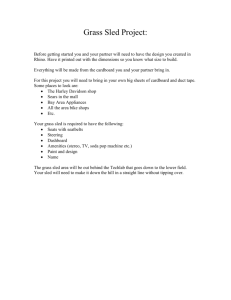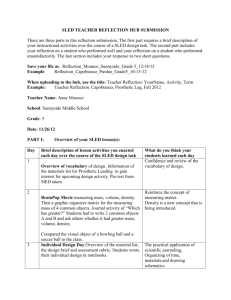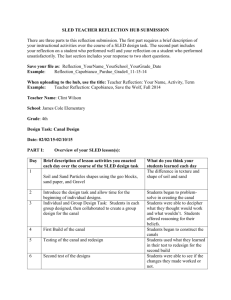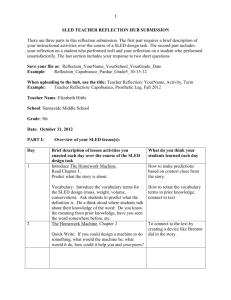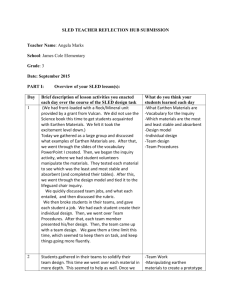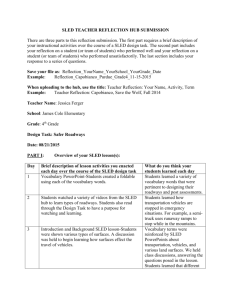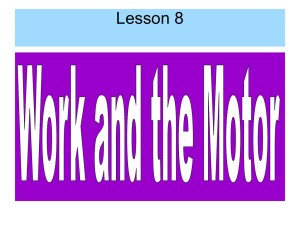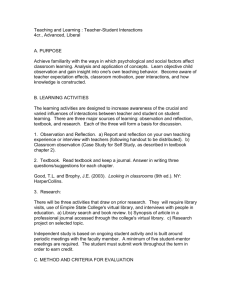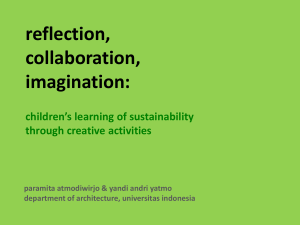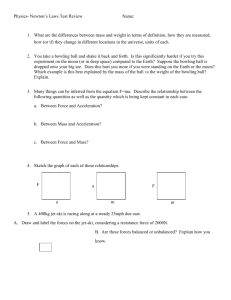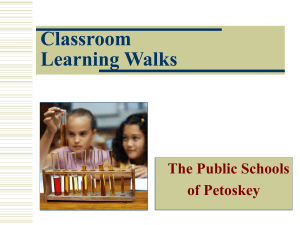purposeful inclined
advertisement
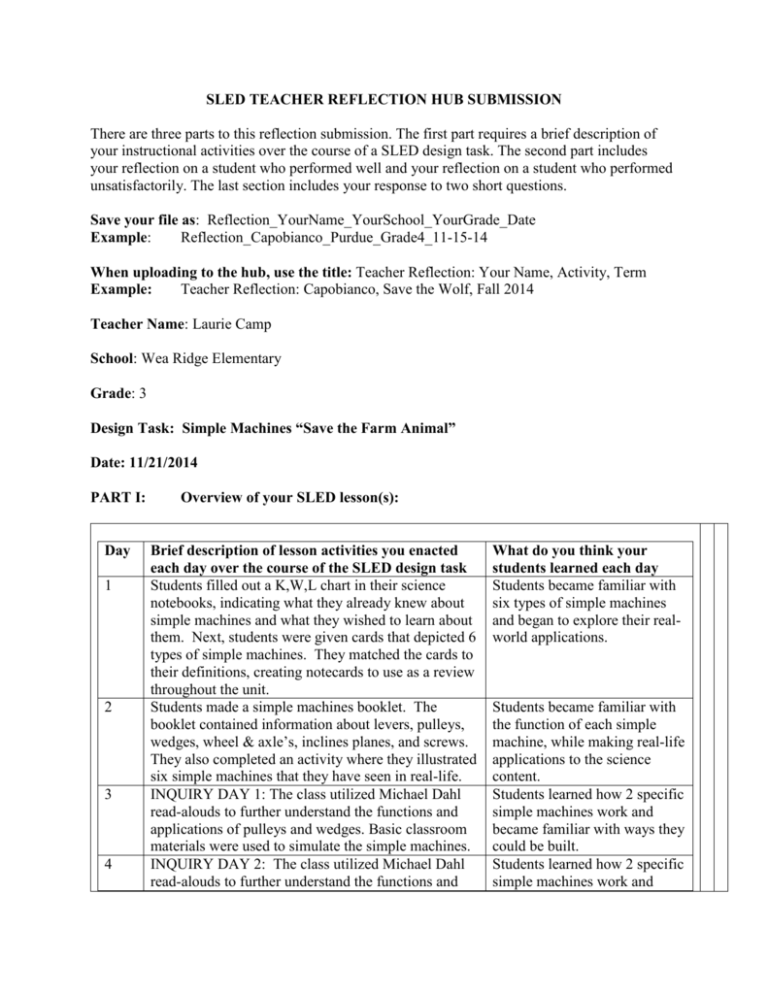
SLED TEACHER REFLECTION HUB SUBMISSION There are three parts to this reflection submission. The first part requires a brief description of your instructional activities over the course of a SLED design task. The second part includes your reflection on a student who performed well and your reflection on a student who performed unsatisfactorily. The last section includes your response to two short questions. Save your file as: Reflection_YourName_YourSchool_YourGrade_Date Example: Reflection_Capobianco_Purdue_Grade4_11-15-14 When uploading to the hub, use the title: Teacher Reflection: Your Name, Activity, Term Example: Teacher Reflection: Capobianco, Save the Wolf, Fall 2014 Teacher Name: Laurie Camp School: Wea Ridge Elementary Grade: 3 Design Task: Simple Machines “Save the Farm Animal” Date: 11/21/2014 PART I: Day 1 2 3 4 Overview of your SLED lesson(s): Brief description of lesson activities you enacted each day over the course of the SLED design task Students filled out a K,W,L chart in their science notebooks, indicating what they already knew about simple machines and what they wished to learn about them. Next, students were given cards that depicted 6 types of simple machines. They matched the cards to their definitions, creating notecards to use as a review throughout the unit. Students made a simple machines booklet. The booklet contained information about levers, pulleys, wedges, wheel & axle’s, inclines planes, and screws. They also completed an activity where they illustrated six simple machines that they have seen in real-life. INQUIRY DAY 1: The class utilized Michael Dahl read-alouds to further understand the functions and applications of pulleys and wedges. Basic classroom materials were used to simulate the simple machines. INQUIRY DAY 2: The class utilized Michael Dahl read-alouds to further understand the functions and What do you think your students learned each day Students became familiar with six types of simple machines and began to explore their realworld applications. Students became familiar with the function of each simple machine, while making real-life applications to the science content. Students learned how 2 specific simple machines work and became familiar with ways they could be built. Students learned how 2 specific simple machines work and 2 5 6 applications of levers and wheel and axels. Basic classroom materials were used to simulate the simple machines. INQUIRY DAY 3: The class utilized Michael Dahl read-alouds to further understand screws and inclines planes. Basic classroom materials were used to simulate the simple machines. MOVIE: Bill Nye Simple Machines Students were introduced to the design task, “Save the Pig” and identified the problem, goal, client, constraints, etc. in preparation for the task. 7 Students completed their individual and group designs. 8 Students designed a prototype of a compound machine to catch a farm animal with their teams. 9 Students tested their prototypes and had the opportunity to redesign. 10 Reflection & Post Assessment became familiar with ways they could be built. Students learned how 2 specific simple machines work and became familiar with ways they could be built. Students learned what their challenge was and began to brainstorm ways that they could meet their goal. Students brainstormed ways that they could incorporate their new knowledge of simple machines into a purposeful compound machine. Students practiced teamwork, while learning what did and what didn’t function as well while trying to make the simple machines on their prototype work together. Students presented their prototypes to the class, sharing what worked and what didn’t work throughout the process. They brainstormed ideas of how they could improve their designs. Students reflected on their prototype’s performances and challenges that they faced. Please answer the questions below: 1. What worked well? For the simple machine design task I wanted the students to get some experience with the materials before they were asked to design and build. My co-worker and I made bags with different materials that they would be allowed to use on the task. After reading the books that we purchased on each machine, I had the kids take a bag and we made each simple machine in small groups. It was amazing to see how creative they were with just a few supplies. The students were able to correctly build each simple machine, identify each simple machine, and explain how it would be used. I found their vocabulary and knowledge of how to use the simple machines to be excellent. The concepts were there and I was pleased with the products. 3 2. What are two ways you can improve your efforts toward integrating design? Our team has worked hard this year (our second year in SLED) to integrate design into our science program. We did a better job of integrating the SLED books into our reading program and using it to teach non-fiction text. I know that one goal we have is to become total SLED for our science. Our team has worked hard on developing foldables and other interactive activities for our notebooks to help teach the standards and to integrate design. 4 PART II: Reflection#1 on student performance: Include an image of work from one student who you thought performed well on the task. Insert the image here within the Word document. This image may be a copy of the student’s notebook entry(s) or an image of the team’s artifact or an actual picture of the student at work. In the space below describe what the image(s) is about and why you would explain or characterize the student’s performance as mastery or excellent. This is a picture of a group’s redesign. I wanted to focus more on the redesign component for this task. After discussing with the group and class about pulleys and what we had learned in the books and computer generated game through Chicago Museum of Science, this group decided to add a second pulley to help do the work. The group also worked on balancing out their animal trap so that the animal would be safe. I felt that adding the second pulley was a good demonstration of what they had learned previously. Given more materials they were able to make a successful product. I also felt using the cup as a base was clever. The group realized that the pole had to have a strong base. 5 Reflection#2 on student performance: Include an image of work from one student who you thought did not perform as well (unsatisfactory) on the task. Insert the image here within the Word document. This image may be a copy of the student’s notebook entry(s) or an image of the team’s artifact or an actual picture of the student at work. In the space below describe what the image is about and why you would explain or characterize the student’s performance as unsatisfactory. The individual design was very detailed. I felt that the group design was unsatisfactory for many reasons. One, the labeling wasn’t the best. Second, the use of the inclined plane had no real significance. It didn’t have a purpose. The inclined plane did not help with the capturing and safety of the animal. In my opinion the group as a whole did not have a clear understanding of how simple machines need to work together to make a compound machine. To solve one purpose. 6 PART II: Reflection #3 Describe one thing you enjoyed about instructing this SLED task. I enjoyed the literacy tie in with the books we purchased through SLED. The books taught the concepts in a clear way and in a way that the kids could relate to. The connection between subjects worked well and it tied into literacy standards using nonfiction. We were also able to tie this into our field trip experience at Fair Oaks. We re-worked the story to fit what we experienced on the field trip (pigs). The design task was our end to the unit. Describe one thing in your practice you would improve upon next time you implement this engineering design task or another SLED design task. I feel I struggle with the designing of the task. If the kids explain their drawings to me, I am able to understand what they are thinking of doing. Getting them to translate that onto paper has been a challenge for me both last year and this year. I felt I improved in teaching sketching, but it doesn’t seem to be showing in the kids’ work. I have a hard time seeing the actual science in their drawings. Verbally they use the terms and can correctly communicate the process, but it isn’t evident in most sketches.
